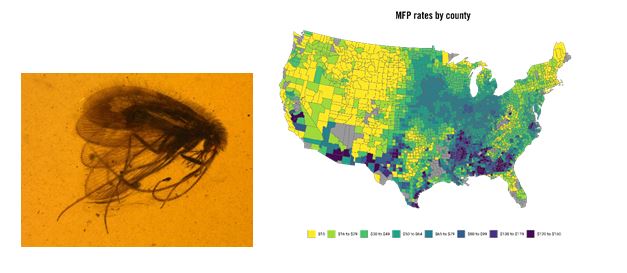AKSON Russian Science Communication Association
Buratina truncata, the new long-proboscid species of Paradoxosisyrinae from Burmese amber, and, MFP map
Credit: Alexander Khramov
A team of paleontologists from the Borissiak Paleontological Institute of Russian Academy of Sciences (Moscow) discovered four new species of extinct insects with sucking mouthparts in mid-Cretaceous Burmese amber. Researchers believe that they visited first angiosperm flowers, but eventually went extinct due to the inefficient design of the proboscis. According to the research, Paradoxosisyrinae, the group to which these creatures belong, is a kind of «Nature’s failed experiment». The results of the study are published in the Cretaceous Research journal.
In recent years, Burmese amber makes headlines as a source of dinosaur remains, toothed birds and other incredible vertebrate findings. However, insects found there are often no less bizarre. This is especially true for Paradoxosisyrinae, a subfamily of Sisyridae, or spongeflies, which was described from Burmese amber based on a single specimen in 2016. Neither living spongeflies nor any of their extant relatives from insect order Neuroptera, such as green lacewings and ant lions, have sucking mouthparts. In contrast, members of Paradoxosisyrinae were equipped with a well-developed proboscis — which is a paradox indeed, as their name suggests.
Until now, functions of Paradoxosisyrinae’s proboscis have remained unclear. It was hypothesized that Paradoxosisyrinae used their elongated mouthparts for piercing insect cuticle or frog skin. Contrary to this, the new research based on newly available specimens shows that in all probability these insects were not predators or bloodsuckers — instead, they were harmless nectar feeders. Scientists said that Paradoxosisyrinae simply could not pierce any dense substrates because of loosely coupled arrangement of the mouthparts, devoid of a supportive sheath, and the presence of long hairs at the mouthpart tips.
With the help of microscope examination and virtual 3D-models scientists came to a conclusion that proboscis of Paradoxosisyrinae, rather than having a common food canal, consists of two independent straws or tubes, each one formed by two halves loosely joined together without any special devices suitable to lock them tightly. Since Paradoxosisyrinae could not seal their proboscis to produce a pressure gradient, as modern flies and moths do, they had to rely exclusively on capillary forces for nectar uptake, while other nectar feeders use also the muscular sucking pump. All this means that the proboscis of Paradoxosisyrinae, less than 1 mm in length, destined to be short forever, which undercut their ability to draw nectar from flowers with deep corolla tubes.
«These insects were a nature”s unsuccessful attempt to make nectar feeding insects in response to the rise of the flowering plants in the Early Cretaceous period. Soon they were outcompeted by bees, flies and other nectar feeders with more cleverly designed mouthparts», said Alexander Khramov, study”s leading author and a senior researcher at the Borissiak Paleontological Institute.
Discovery of four new species of Paradoxosisyrinae, in addition to the only previously known member of this subfamily, dramatically expands our knowledge about diversity of these extinct nectar feeders. One of the new species was named Buratina truncata after the long-nosed fiction character Buratino, the Russian analogue of Pinocchio. Body of Buratina truncata as well as of other newly described species was covered with dense hairs, the condition seen in modern pollinators, which allows them to carry pollen grains between plants. The researchers say that Paradoxosisyrinae could feed on small shallow flowers like Tropidogyne which are commonly occur in Burmese amber.
______________________________________________________________________________________________________________________________________
Amid Trade War, Farmers to Collect Largest Federal Payments in 14 years
By: Chuck Abbott
Farmers and ranchers will receive a projected $10.7 billion in Trump tariff payments this year, the major reason that direct federal payments will amount to 22 percent of net farm income, say USDA economists. The trade war payments would be twice as large as last year’s $5.1 billion, when the administration created the stop-gap Market Facilitation Program to mitigate the impact of the Sino-U.S. trade war on the agricultural sector.
The USDA estimated net farm income, a measure of profits, at $88 billion this year, up by 5 percent from $84 billion in 2018. Income in both years would be much higher than initially thought, due to large farm program payments and to aggressive cost-cutting by producers. This year’s farm program payments would be the largest since $24.4 billion in 2005. The commodity boom that began in 2006 reduced federal payments to around $11 billion annually.
The estimate of $19.5 billion for payments this year includes $10.7 billion in Trump payments, $2.3 billion in traditional crop subsidies, $1.7 billion in disaster aid and $3.7 billion for land stewardship, such as the long-term Conservation Reserve. In total, the payments, at 22 percent of net farm income, would be the highest since 28 percent in 2006, according to USDA data.
In the end, the Trump payments could be larger than USDA anticipated in updating its farm income forecast. “We assume producers will receive 50 percent of the announced total of $14.5 billion in the first tranche,” said the Economic Research Service. Senior USDA officials say a second tranche, of $3.6 billion, may be disbursed in November, if market and trade-negotiation conditions warrant, with the final $3.6 billion possible in January.
With its updated figures, the USDA presented a much brighter picture of farm income than in its March forecasts of $63.1 billion in 2018 and $69.4 billion this year; roughly half of the $123.7 billion seen in 2013 at the crest of the commodity boom. Farm groups and allies in Congress have pointed to the estimates of low farm income in arguing for federal intervention.
“We had a pretty big adjustment in net farm income,” said Warren Preston, deputy USDA chief economist, in a USDA radio news interview. “Farmers were able to reduce their expenses again, as they have been doing for the last several years.” Farmers and ranchers sliced total expenses by $25 billion, or 7 percent, in 2018, said USDA, which made a similar 7 percent reduction in its estimate of 2019 expenses.
If the forecast of $88 billion proves true, “inflation-adjusted net farm income would remain slightly below its historical average across 2000-18” of $90.1 billion, said USDA. Market prices for crops are higher than in 2018 but harvests of corn and soybean are expected to be smaller than last year, keeping crop revenue 2 percent below the 2018 level. Conversely, livestock production is up but prices are down, limiting revenue to a 0.5 percent increase.
The debt-to-asset ratio, a closely watched indicator of solvency, was forecast to rise to 13.5 percent this year, from 13.3 percent in 2018. The debt-to-equity ratio also would tick upward. “The farm sector’s solvency ratios are forecast to be at their weakest points since 2009 but close to their long-term averages from 1990 to 2018,” said the USDA.
Farm assets were estimated at $3.1 trillion, up $59 billion or 2 percent this year, while debts would total $416 billion, up by $14 billion or 3 percent, from 2018.
______________________________________________________________________________________________________________________________________








